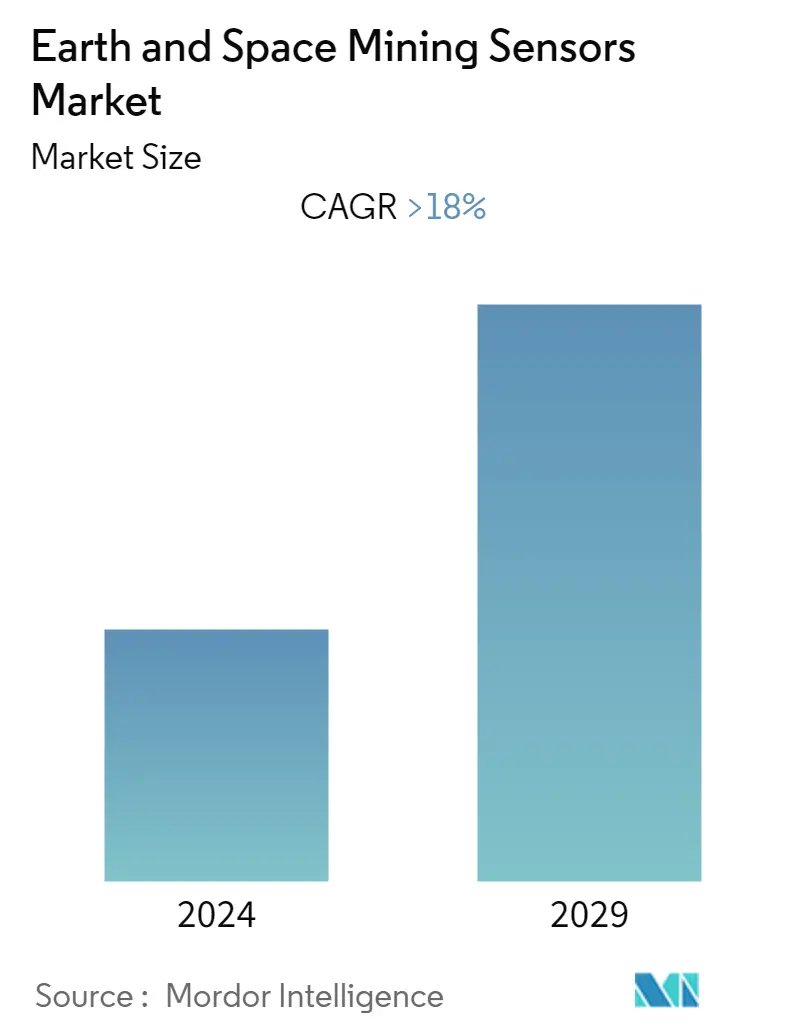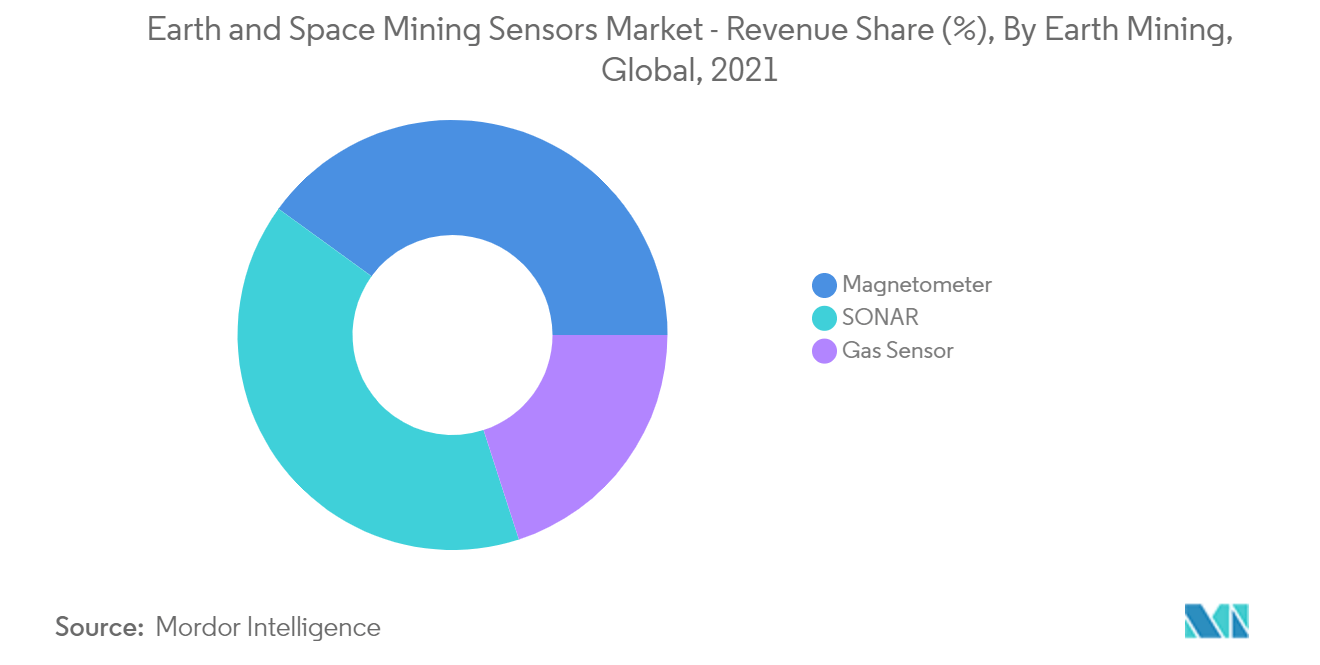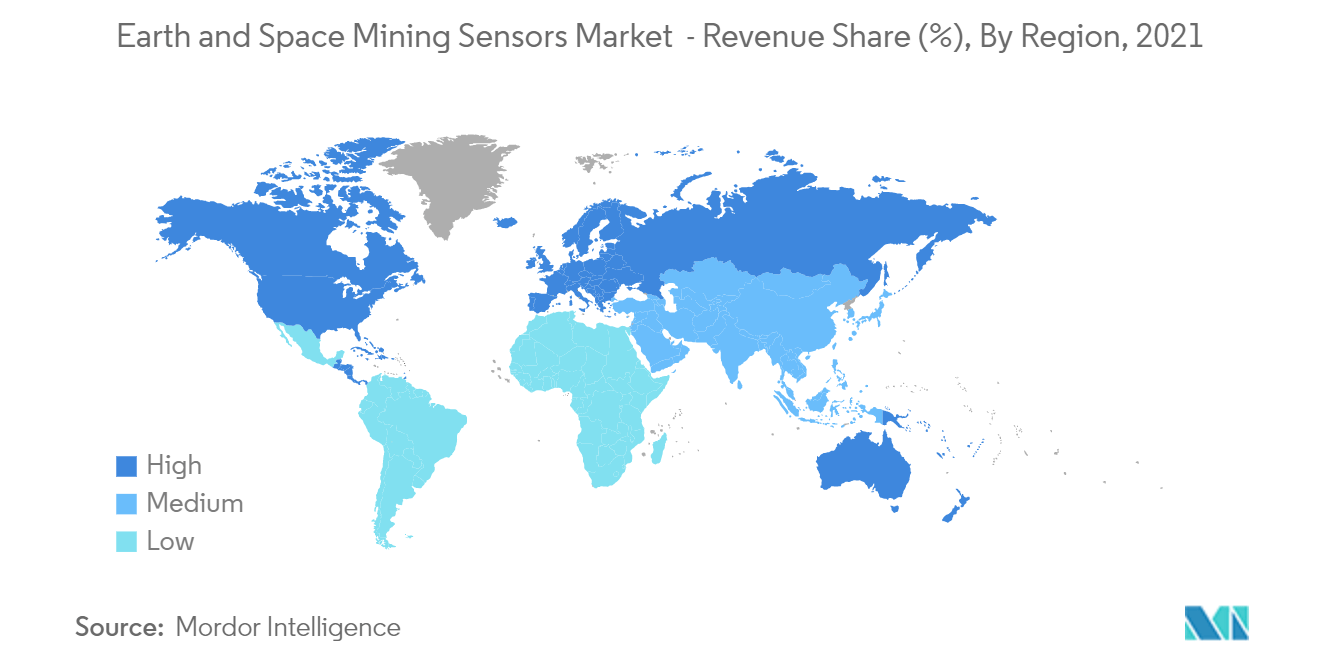Earth & Space Mining Sensors Market Size

| Study Period | 2019 - 2029 |
| Base Year For Estimation | 2023 |
| CAGR | 18.00 % |
| Fastest Growing Market | North America |
| Largest Market | Asia-Pacific |
| Market Concentration | High |
Major Players.webp)
*Disclaimer: Major Players sorted in no particular order |
Earth & Space Mining Sensors Market Analysis
The Earth and Space Mining Sensors Market is expected to register a CAGR of over 18%, during the forecast period, 2022-2027.
The COVID-19 pandemic had a negligible impact on the space mining market over the last two years. Although slight delays were observed in the manufacturing sector, most of the space mining programs are back on track with the industry slowly moving toward the commercialization of space mining activities.
In[SS1] [PP2] 2015 when the US government implemented the Space Law, which permits US-based companies to conduct space mining operations on asteroids and other space resources. The Space Law ushered in a new era in space mining, as most companies started investing in developing probes capable of approaching asteroids to exploit their innumerable resources.
Potential, economic, scientific, and even security benefits underlie an emerging geopolitical competition to pursue space mining. The industry is slowly moving toward the commercialization of space mining activities. In 2020, Japan's Hayabusa2 spacecraft brought back samples from a near-Earth asteroid Ryugu. At the same time, NASA has awarded contracts to four companies to extract small amounts of lunar regolith by 2024, effectively beginning the era of commercial space mining.
Besides the United States, Luxembourg, and the United Arab Emirates are racing to develop space mining laws, hoping to attract investment to their entrepot nations with business-friendly legal frameworks. While China reportedly views space-resource development as a national priority, as part of a strategy to challenge the US economic and security primacy in space, Russia, Japan, India, and the European Space Agency harbor space-mining ambitions of their own.
The development of a global framework and the growing enthusiasm from the private sector, along with the advent of a feasible space mining technology and reduction in project costs, is expected to radically boost the space mining efforts of the countries, which would require mass production of landers and rovers to survey a mining site prior to setting up a mining rig on any celestial body.
On the other hand, the high costs associated with the space mining programs along with the technical and technological challenges in space mining might restrict the prospective investors, thereby affecting the growth of the space mining market.
[SS1]Market CAGR paragraph and Covid-19 impact is missing
[PP2]done
Earth & Space Mining Sensors Market Trends
This section covers the major market trends shaping the Earth & Space Mining Sensors Market according to our research experts:
Various Government Initiatives Aimed Toward Space Mining
Various space programs are traditionally aimed at identifying the structure and origin of the universe and exploration of other planets. However, currently, the idea of space mining evolved to be increasingly legitimate among various space ventures and governments. Governments are issuing licenses to parties planning to conduct activities in space, and some countries are enforcing their regulations for space mining.
According to Article II of the 1967 Outer Space Treaty, outer space, including the moon and other celestial bodies, is not subject to national appropriation by claim of sovereignty, by means of use or occupation, or by any other means. The treaty, overall, stresses the prohibition of weapons that might cause mass destruction in space, on the Moon or any other celestial body and explicitly forbids any claims on a celestial resource based on the fact that they are the common heritage of mankind.
Even though this treaty indirectly prohibits the mining of celestial resources, countries are focusing on establishing the legitimacy of space mining by passing their own laws, acts, and regulations. For instance, the Commercial Space Launch Competitiveness Act, enacted by the United States in 2015, encouraged private companies to undertake mining work beyond Earth. However, since the UN International Treaty of Outer Space does not permit nations to have territories in space, the US cannot reserve sovereignty rights to any celestial body.
Luxembourg aims to become Europe's space mining hub in the coming years. Also, in February 2021, Luxembourg announced that its space program would work with Nasa on moon mining.
In 2020, the US administration has created new rules through an executive order following the 2015 law change for how those companies might profit from operations on the Moon, asteroids, and other planets. The administration also plans to encourage other nations to adopt this new US perspective on space mining.
In July 2021, Japan has passed the Law for the Promotion of Commercial Activities Related to the Exploration and Exploitation of Space Resources, which allows Japanese companies and private capital to access, search for, find, exploit and obtain ownership of minerals extracted from the surface and subsurface of the Moon, Mars or other outer bodies.

North America is Expected to Dominate the Market
One of the major challenges facing the space mining industry is the huge cost of programs. The transport cost of bringing mined resources down to Earth will be far less than its worth to the recipient. However, those costs have come down almost ten-fold in the last two decades, with more reductions promised.
Space agencies and private companies have been trying to reduce the costs of the space launch systems over the past few years. Many market players have invested in the development of reusable launch systems with the recovery of some or all the component stages.
Many other prominent companies are also working toward developing similar technologies related to reusable launching vehicles. Blue Origin is developing a New Glenn partially-reusable orbital rocket, as it intends to recover and reuse only the first stage. The debut of the rocket is scheduled for late 2022. Furthermore, in February 2020, ArianeGroup and CNES (the French space agency) signed a memorandum of understanding for a new "acceleration platform" that will work to develop new launchers, including reusable ones.
the adoption of In-Situ Resource Utilization (ISRU) practice in space exploration is being focused upon. ISRU is the practice of collection, processing, storing, and use of materials found or manufactured on other astronomical objects (the Moon, Mars, asteroids, etc.) that replace materials that would otherwise be transported from Earth. Many planets, moons, and asteroids contain a rich diversity of inert physical substances such as metals, along with gases and water that could be used as energy sources for mining processes as well as means to sustain human life as we venture deeper into space.
Players in the market have started to work in this regard. In September 2021, Airbus has signed a memorandum of understanding with the Mexican Space Agency (AEM) and the Mexican start-up Dereum Labs to collaborate on the technologies needed for lunar resource extraction.

Earth & Space Mining Sensors Industry Overview
The earth and space mining sensor market is consolidated. Honeywell International, Rockwell Automation, STMicroelectronics, Texas Instruments, Amphenol Corporation, Siemens, DENSO Corporation, Robert Bosch GmbH, InnaLabs, Deltion Innovations, CSIRO are the main players operating in the earth and space mining sensor industry.
Earth & Space Mining Sensors Market Leaders
-
Honeywell International
-
DENSO Corporation
-
Singapore Technologies Engineering Ltd
-
Rockwell Automation, Inc.
-
Texas Instruments Inc.
*Disclaimer: Major Players sorted in no particular order
.webp)
Earth & Space Mining Sensors Market News
In November 2021, Scientists at Pennsylvania State University developed a new sensor that detects the rare earth element terbium. The sensor was developed from a protein in the Methylorubrum extorquens bacterium, which can be found on soils and in plants. Scientists used tryptophan to excite the terbium, which then emits light at different wavelengths.
In August 2021, NASA awarded YSD 500,000 to competitive teams to design and nurture the moon mining technology. This is expected to significantly help technological growth in the market.
Earth & Space Mining Sensors Market Report - Table of Contents
1. INTRODUCTION
- 1.1 Study Deliverables
- 1.2 Study Assumptions
- 1.3 Scope of the Study
2. RESEARCH METHODOLOGY
3. EXECUTIVE SUMMARY
4. MARKET DYNAMICS
- 4.1 Market Overview
- 4.2 Market Drivers
- 4.3 Market Restraints
- 4.4 Value Chain / Supply Chain Analysis
-
4.5 Porters 5 Force Analysis
- 4.5.1 Threat of New Entrants
- 4.5.2 Bargaining Power of Buyers/Consumers
- 4.5.3 Bargaining Power of Suppliers
- 4.5.4 Threat of Substitute Products
- 4.5.5 Intensity of Competitive Rivalry
- 4.6 PESTLE Analysis
5. MARKET SEGMENTATION
-
5.1 Earth mining
- 5.1.1 Magnetometer
- 5.1.2 SONAR
- 5.1.3 Gas Sensor
-
5.2 By space mining
- 5.2.1 Laser Sensors (Mineral Spectrometry)
- 5.2.2 Gas Sensors (Element Analysis)
- 5.2.3 Gyroscope Sensors
-
5.3 Geography
- 5.3.1 North America
- 5.3.1.1 US
- 5.3.1.2 Canada
- 5.3.1.3 Mexico
- 5.3.1.4 Rest of NA
- 5.3.2 Europe
- 5.3.2.1 Germany
- 5.3.2.2 UK
- 5.3.2.3 France
- 5.3.2.4 Russia
- 5.3.2.5 Spain
- 5.3.2.6 Rest of NA
- 5.3.3 Asia Pacific
- 5.3.3.1 India
- 5.3.3.2 China
- 5.3.3.3 Japan
- 5.3.3.4 Rest of AP
- 5.3.4 Rest of the world
6. COMPETITIVE LANDSCAPE
- 6.1 Vendor Market Share
- 6.2 Mergers & Acquisitions
-
6.3 Company Profiles
- 6.3.1 Honeywell International
- 6.3.2 Rockwell Automation
- 6.3.3 Texas Instruments
- 6.3.4 Amphenol Corporation
- 6.3.5 Siemens
- 6.3.6 DENSO Corporation
- 6.3.7 STMicroelectronics
- 6.3.8 Robert Bosch GmbH
- 6.3.9 InnaLabs
- 6.3.10 Deltion Innovations
- *List Not Exhaustive
7. MARKET OPPORTUNITIES AND FUTURE TRENDS
** Subject To AvailablityEarth & Space Mining Sensors Industry Segmentation
A sensor is a device that produces an output signal for the purpose of sensing a physical phenomenon. In the broadest definition, a sensor is a device, module, machine, or subsystem that detects events or changes in its environment and sends the information to other electronics, frequently a computer processor.
Modern mining is adopting advanced sensor-based technologies to effectively detect minerals. Sensors are used in each step of the mining operation, from mine exploration, surveying, and underground mapping to ore extraction, sorting, and mineral processing. Laser, Gas, and Gyroscope sensors for space mining applications, along with Gas, SONAR, and Magnetometer sensors for earth mining applications were considered for this market study.
The earth and space mining sensor market is segmented by Earth mining, by space mining and by Geography. By Earth mining, the market is segmented into Magnetometer, SONAR, Gas Sensor. By space mining, the market is segmented by Laser Sensors (Mineral Spectrometry), Gas Sensors (Element Analysis), and Gyroscope Sensors.
| Earth mining | Magnetometer | |
| SONAR | ||
| Gas Sensor | ||
| By space mining | Laser Sensors (Mineral Spectrometry) | |
| Gas Sensors (Element Analysis) | ||
| Gyroscope Sensors | ||
| Geography | North America | US |
| Canada | ||
| Mexico | ||
| Rest of NA | ||
| Geography | Europe | Germany |
| UK | ||
| France | ||
| Russia | ||
| Spain | ||
| Rest of NA | ||
| Geography | Asia Pacific | India |
| China | ||
| Japan | ||
| Rest of AP | ||
| Geography | Rest of the world |
Earth & Space Mining Sensors Market Research FAQs
What is the current Earth and Space Mining Sensors Market size?
The Earth and Space Mining Sensors Market is projected to register a CAGR of greater than 18% during the forecast period (2024-2029)
Who are the key players in Earth and Space Mining Sensors Market?
Honeywell International , DENSO Corporation , Singapore Technologies Engineering Ltd, Rockwell Automation, Inc. and Texas Instruments Inc. are the major companies operating in the Earth and Space Mining Sensors Market.
Which is the fastest growing region in Earth and Space Mining Sensors Market?
North America is estimated to grow at the highest CAGR over the forecast period (2024-2029).
Which region has the biggest share in Earth and Space Mining Sensors Market?
In 2024, the Asia-Pacific accounts for the largest market share in Earth and Space Mining Sensors Market.
What years does this Earth and Space Mining Sensors Market cover?
The report covers the Earth and Space Mining Sensors Market historical market size for years: 2019, 2020, 2021, 2022 and 2023. The report also forecasts the Earth and Space Mining Sensors Market size for years: 2024, 2025, 2026, 2027, 2028 and 2029.
Earth and Space Mining Sensors Industry Report
Statistics for the 2024 Earth And Space Mining Sensors market share, size and revenue growth rate, created by Mordor Intelligence™ Industry Reports. Earth And Space Mining Sensors analysis includes a market forecast outlook to 2029 and historical overview. Get a sample of this industry analysis as a free report PDF download.



